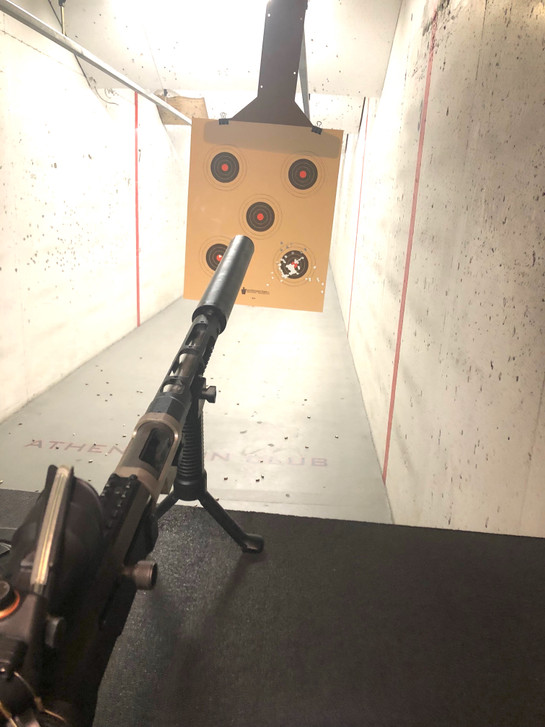The fundamental difference between open and closed bolt blowback SMGs:
Closed bolt systems fire from a resting position where the bolt is at rest on the chamber. At the point of firing the bolt mass is stationary and only the hammer and firing pin are moving. The bolt mass in open bolt fixed firing pin blowback systems constantly move until the sear interrupts the cycle process by holding the bolt rearward.
Crafty designers have used the reciprocating bolt mass, mainspring design, bolt travel distance, buffer design, and bullet recoil to cancel the pushes and pulls from the shooter’s shoulder thereby maximizing accuracy and control in full auto. During WW2 Hugo Schmeisser pioneered these full auto systems which are best described as constant recoil or recoil neutral systems.
Let’s Look at Two Extremes: The U9SF vs the Colt 9mm SMG
The Colt 9mm SMG also known as the Dept Of Energy (DOE) setup fires from the closed bolt position with a hammer striking a firing pin and no locking system. It jumps and jerks it through full auto, and kicks harder than an M4. Vickers Tactical did a great video on this gun and the physics at play. Take a look at the 3:56 mark of this Vickers Tactical video. You can clearly see three distinct impulses and muzzle jumps for each shot:
1) Bullet Recoil from the bullet leaving the barrel.
2) Buffer Recoil from the buffer smacking the rear of the buffer tube at the end of the bolt stroke.
3) Chambering Push from the bolt slamming the cartridge into the chamber and pushing the gun forward just prior to the hammer strike.
For shooters this results in a jumpy and jerky feel as well as accuracy destroying muzzle flip while bursting. While closed bolt guns may have an edge in first shot accuracy, they have some major disadvantages in full auto bursts. By adding a locking system or delayed blowback system (e.g. MP5) designers can mitigate these impulses but they can only be eliminated in an open bolt system.
The U9SF
Unlike most machine guns, the U9SF does not jump or rise. This system maintains stability within long full auto bursts.
By firing from the open bolt position we can minimize Chambering Push and Bullet Recoil. Here’s how: Pulling the trigger depresses the sear, the bolt lunges forward under mainspring pressure and chambers the cartridge. The firing pin fixed on the bolt face contacts the primer and detonates the cartridge as the bolt momentum is still moving forward. The Bullet Recoil effectively cancels the forward Chamber Push of the bolt mass. Further, the bolt does not accelerate rearward as fast as a closed bolt system since reversing the direction of the bolt mass (still moving forward) requires much more energy consumption than if the bolt was at a rest position upon firing. By having to change the direction of the bolt mass the fired case dwells in the chamber longer thereby allowing chamber pressure to decrease to safer levels.
So what’s left?….. Buffer Recoil. If we look at an original M11, they are known to be wild and uncontrollable largely due to the amount of force impacting the rear of the receiver. The original M11 has relatively low bolt mass, a short stroke, and lacks a good buffer system. As a result the bolt moves very fast and violently impacts a buffer which does little to mitigate recoil.
The U9SF long-stroke bolt system with hydraulic buffer is specifically designed to minimize recoil in full auto along the lines of constant recoil or recoil neutral systems. The rearward energy in the bolt movement is dissipated by the resistance of the mainspring during the long bolt travel. What’s left of the rearward energy is further dissipated by the hydraulic compression of the buffer.
Since the rearward impulse from the round exiting the barrel cancels the forward momentum of the bolt mass and the bolt never ‘smacks’ the rear of the receiver, there is little forward or rearward forces felt at the shooter’s shoulder. This means that recoil is effectively cancelled within a full-auto burst. As the machine gun is chopping its way through a drum it is recoil-neutral and simply ‘floats’ in the shooter’s hands allowing easy control. The result is a very smooth and controllable full auto experience as well as tight groups.
Check out these videos:

